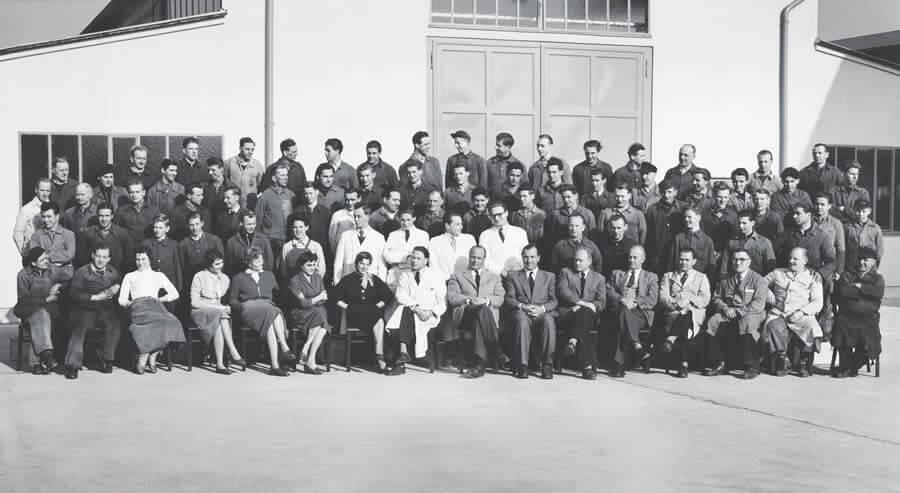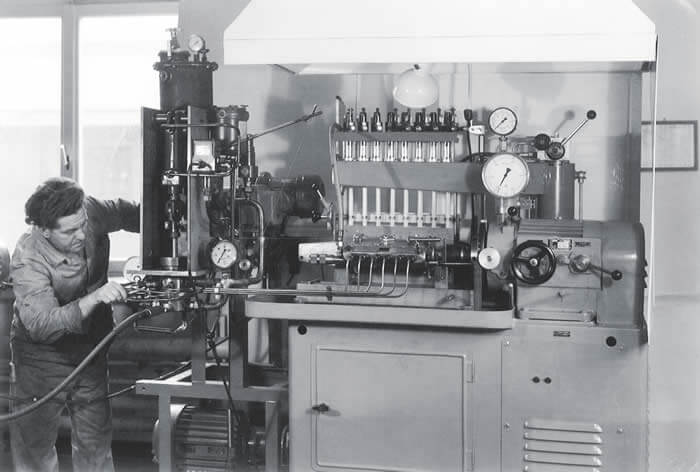Definitely nothing to sneer at
The worldwide success story of polyurethane
Otto Bayer’s discovery of polyurethane in 1937 might have been accidental but the substance’s subsequent triumph and its universal application can be attributed clearly to the innovative powers of Hennecke GmbH.
In the beginning there was an experiment: The chemist Otto Bayer was looking for a process to manufacture synthetic fibres when something went wrong. Some small amounts of acid found their way into the mixture and the mass foamed up. A fellow chemist’s sneering judgment after the first results was that the material was “at best good for making imitations of Emmental cheese.” Otto Bayer and his team refused to be discouraged – they added some water to the reactive mix, causing the carbon dioxide to separate and small bubbles to form and the first polyurethane foam was born.
Pioneers of the first hour
On 1st November 1945, Karl Hennecke, a department head at Dynamit Nobel AG in Troisdorf who had decided to take his luck into his own hands, founded “Maschinenfabrik Karl Hennecke” in Sankt Augustin-Birlinghoven near Bonn. He did not yet know that he was laying the foundation stone for what would become one of the most successful companies for manufacturing polyurethane processing technology in the world – today’s Hennecke GmbH.
Although the first innovations – laminating machines, textile washing systems, chocolate powder mills – still seemed very exotic, Karl Hennecke recognized the significance of polyurethane products and the growing demand for them at an early stage. This is why he readily agreed when Farbenfabriken Leverkusen was looking for a partner to build so-called polyurethane injection machines and thus the Maschinenfabrik Karl Hennecke started out in the polyurethane sector.

From a machine factory with four workers to global player
The fact that polyurethane boomed was closely linked to the history and innovative powers of Hennecke GmbH. The first machines for making flexible slabstock foams in boxes emerged in the early 1950s. Hennecke’s global orientation and activities can largely be attributed to the worldwide demand for its machines. Right from the start, Hennecke’s UBT plants for manufacturing slabstock in a continuous process enjoyed a very good reputation. Gradually, polyurethane machines replaced the company’s other products and employee numbers rose alongside the expanding range of machines.
When Karl Hennecke died in 1962, there were 169 employees and the annual turnover was 6.5 million DM. The company's portfolio of PU machines continued to develop successfully and sales volumes increased steadily. High-pressure metering machines had been added to the product range in the late 1950s. The impingement mixing principle used in HK machines was completely new at the time, and this is still symbolized in Hennecke’s company logo today as two arrows directed at each other. Hennecke had a monopoly on the technology until the patent ran out.

From 1966 onwards, double conveyors for the continuous manufacture of rigid polyurethane foam panels with a completely new design were made – these were yet another example of the plant manufacturer’s innovative powers and willingness to take risks. In order to securely supply the market with machines, Bayer became a major shareholder in Hennecke at the end of 1967 and the company was renamed “Maschinenfabrik Hennecke GmbH”. Bayer AG acquired the company in 1975. Hennecke entered new ground at the beginning of the 1970s when it participated in big projects in Russia and Poland. It was still very early days for the manufacture of polyurethane machines and there was hardly any literature on the subject. However, Hennecke took on the challenge and mastered it. At the same time, Professor Menges at the Institute of Plastics Processing in Aachen laid the foundation stone for the scientific processing of polyurethane. Hennecke has always supported the institute.
Gradually, market relations changed and Hennecke began to meet with more and more competition. However, whereas many of its competitors only covered parts of the market, Hennecke provided a comprehensive programme of PU machines and equipment that expanded systematically in the 1970s to include, for example, moulded foam lines for making hot and cold cure foam, various refrigerator production lines, systems for making skis, window profiles, Baydur moulded foam lines and flat fop equipment for rigid foam. In the 1980s, Hennecke drew a lot of attention with its RIM technology that helps the automotive industry manufacture large parts. Thus, the construction of RIMDOMATS and big clamping units became a firm part of the programme. Activity on the foreign market also increased significantly. In 1979, the German-Brazilian joint venture Hennecke Equipamentos was set up in Sao Paolo, and in 1980 the subsidiary Hennecke France was founded. In 1982, a licensing agreement was made with the Japanese company Meg Maruka, in which Hennecke took a share after 10 years of successful cooperation. Hennecke has been active in the United States since the 1960s and its sister firm Hennecke Inc. in Pittsburgh is still one of the most important foreign branches today.
China’s economic opening has also brought Hennecke more business. Hennecke started supplying PU systems to China in 1983. The company’s activities also heralded the way for intensive work in other East Asian countries. The significance of this business is reflected by the branch in Singapore. The 1980s were marked by the trend towards automation. During this time, Hennecke built many highly-automated systems and delivered them across the world. Like many other companies, Hennecke was also hit by the worldwide economic crisis in the 1990s, but thanks to its innovative technologies – such as Pentane Processing Technology – it was able to ensure its position on the market. Since 1997, the company has been called “Hennecke GmbH” and since 2008, Hennecke has been a wholly-owned daughter company of the Adcuram Group.
Hennecke – the driving force behind PU processing technology
Every year, the worldwide use of polyurethane rises by about 5 percent. With its universal applications the material can be found in all walks of life – in living rooms or cars for instance. It can be used to keep food fresh or to make energy-efficient insulation for walls and roofs in the private and industrial sectors. And the possibilities for using PU systems are far from exhausted. It is also convincing from an environmental point of view: Polyurethane consumes only 0.2. percent of the crude oil that is produced annually and yet it saves millions of tons of fuel because of its insulating properties. When used to make lightweight components for cars it minimises the consumption of petrol and diesel, whereas in refrigeration equipment it guarantees lower energy costs. Overall, it also saves valuable resources thanks to recycling technologies. Hennecke has played an important part in this development because the plant manufacturer provided the systems technology and thus the basis for the worldwide triumph of the versatile material and the resulting growth rates of the PU industry. The American Polyurethane Foam Association has therefore honoured Hennecke with a place in its Hall of Fame. Over 500 patent ideas have emerged since 1945 in cooperation with Bayer AG. Continuous manufacture of slabstock foam, the flat-top process for efficient block foaming, high-pressure mixing of PU components and the development of the first high-pressure metering machines, the NOVAFLEX® process for manufacturing flexible slabstock with natural CO2 as a blowing agent, the expanded NOVAFLEX®-MULTIFILL technology for processing fillers in batch or online processes, the Pentane Processing Technology for making CFC-free foams for refrigeration equipment, CLEARRIM technology for coating high-grade surfaces, PUR-CSM spray technology for making lightweight and high load-bearing PU parts reinforced with glass or natural fibres as well as the HP-RTM technology for the production of fibre-reinforced structural components are just some of the highlights. Hennecke has also built the biggest slabstock plant in the world, the most efficient double conveyor and the largest fully-automated and flexible production line for foaming refrigeration equipment.
The company, which employs over 450 people worldwide, and has production sites in Germany, the USA, Japan and China, as well as branches in almost all countries, is one of the most important suppliers of PU technology today, and is considered the PU plant manufacturer with the widest range of products.




